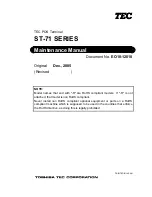
MAN0974-11-EN_XL7_UserManual
March 22
nd
, 2020
Page 174 | 195
20.3 Modbus Master Overview
For complete Modbus Master instructions, please refer to the Help file in Cscape.
When acting as a Modbus master, there are two primary mechanisms used by the XL7 to allow
the user to specify the data to be read/written from/to the slaves.
Modbus Master Function Block
—
This is for serial only. This is an advanced feature that should
only be used in rare occasions.
Protocol Config
—
The Protocol Config is configured in the Hardware Configuration dialog box
in Cscape (serial). Refer to the
. This is the preferred method in
most applications.
After the protocol has been selected from the dropdown menu, the Network, Devices, and
Scan List become available. The Protocol Config is configured on three different levels:
•
Network
—
Parameters, such as the polling rate of the data scan, are specified along
with timeout values, retry, and re-acquisition settings. Serial configuration, baud rate,
parity, etc. are also set here.
•
Devices
—
For every slave to be polled, configuration details are added in the Devices
dialog box. This includes Slave ID (serial). Under Device Type, the Modbus addressing
style matching that specified in the slave’
s user documentation may be selected. For
instance, some slaves specify Modbus addresses (i.e. 40,001), and others specify
offsets (i.e. 0000).
o
Hex or Decimal
—
Some specify addresses in hex, and others in decimal. By
allowing the user to select the Modbus addressing style for each slave on the
network, minimal address conversion is required. Also, if the slave is another
Horner product (i.e. another OCS), the “Native Addressing” option can be
selected (i.e. %R1, %M17, etc.), and this skips the conversion to Modbus style
altogether.
•
Scan List
—
This is where the specific Modbus addresses to be read/written from/to
each slave are specified. Up to 32 words of data can be read at the same time.
NOTE: Once configuration has been completed on the Network and Devices level,
Modbus data can be directly read/written from graphics objects in the Cscape screen
editor. This is available even if the Modbus register is not listed on the scan list.
The above information is just an introduction to the topic. For more detailed information,
please consult the Cscape Help file.
















































